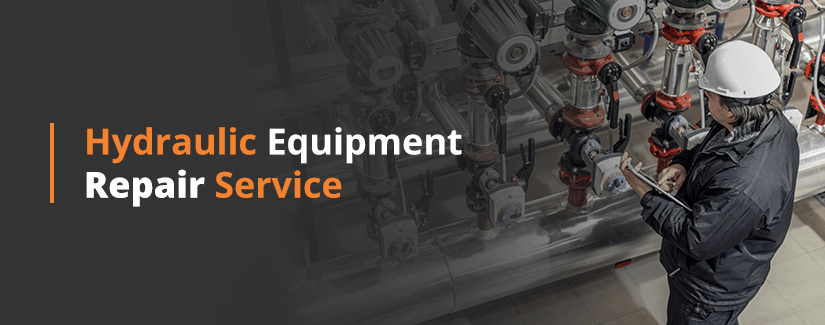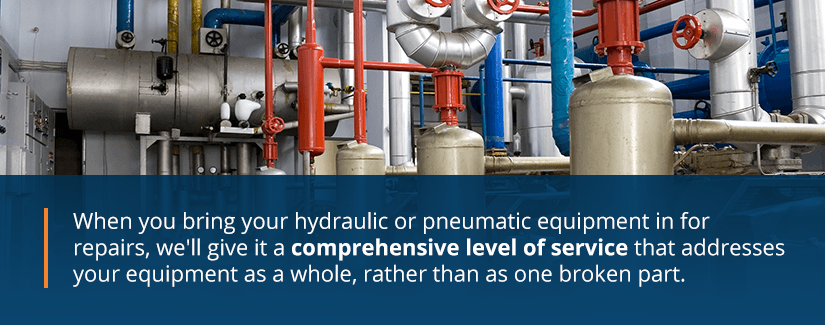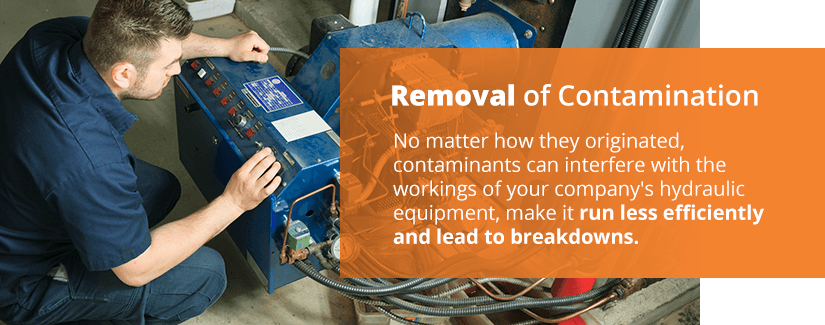Hydraulic & Pneumatic Repair
Services
Hydraulic Equipment Repair Service

Repairs are an inevitable part of owning and operating machinery — U.S. census data suggests that companies spend about $50 billion on maintenance and repairs annually. When a piece of hydraulic equipment breaks down, you’ll want to take it in for repairs quickly to minimize downtime and revenue losses. Even small amounts of downtime can lead to substantial production delays, lost profits and impatient customers. Luckily, Global Electronic Services can help with our industrial hydraulic maintenance and repair services.
In-House Industrial Hydraulic Maintenance Services
For hydraulic repair services at our facilities — always performed by certified and trained technicians — we offer a complete review of your equipment. Plus, our turnaround times are typically between one and five days, so in most cases, you’ll have your equipment back in top shape in very little time. We perform our hydraulic repair services in-house to ensure the highest quality, attention to detail and quality for your valuable equipment. But we also offer on-site service for when you can’t easily transport your machinery.
Our Hydraulics and Pneumatics Process

When you bring your hydraulic or pneumatic equipment in for repairs, we’ll give it a comprehensive level of service that addresses your equipment as a whole, rather than as one broken part. Our hydraulics and pneumatics repairs follow a rigorous process that includes the following services:
1. Disassembly
The hydraulic repair process begins with a systematic disassembly process. Our practiced technicians remove each component and set it aside. A controlled, precise disassembly procedure helps ensure the equipment remains protected and scratch-free throughout the process. A controlled disassembly process also allows technicians to look over each component of the equipment and assess any damage or wear and tear they need to address. Meticulous disassembly is the first step toward a quality repair job, and it is a step our technicians approach with great care.
2. Cleaning and Inspection
Cleaning and inspection are the next steps. Cleaning removes built-up oil, grease, dirt and other grime. It allows the technician to see the components more easily — and a thorough, detailed examination of those components helps the technician locate the source of the problem and diagnose it accurately.
Generally, a hydraulic repair service technician will evaluate a piece of equipment for telltale signs of a problem, such as broken or swelling seals, worn-out piston rods, cracked welds, scored shafts and other clues about what may be amiss. During this inspection, the technician will also measure the equipment’s components and check the measurements against the manufacturer’s measurements.
3. Full Testing and Repair of Onboard Electronics
After cleaning and inspecting the equipment’s components, the technician moves on to a thorough test of the equipment’s onboard electronics. Testing the electronic components helps the technician determine where problems may originate and offers clues about how to address issues. Once testing and diagnosis are complete, the technician can begin to repair the onboard electronics, if necessary. As with other components, we perform all electronic repairs in-house, so downtime will be minimal.
4. Elimination of Scoring From Pistons and Shafts
As we repair hydraulic equipment, we also check the pistons and shafts for scoring or pitting. We then eliminate the scoring by using one of a few different methods. If the chrome surface of the piston rod contains small amounts of scoring, we may be able to polish the scoring out. Otherwise, we may re-chrome the piston rod. For other components of the piston or shaft, we may use a honing tool that allows us to hone away pitting and scoring and leave the parts looking and functioning like new.

5. Removal of Contamination
During the hydraulic repair process, we also remove any contamination we find on the surfaces of different components. Sometimes chemical contaminants, such as corrosive cleaners, may build up on the components of hydraulic equipment. Occasionally, other contaminants, such as oil and grease, may accrue and gum up the parts. No matter how they originated, contaminants can interfere with the workings of your company’s hydraulic equipment, make it run less efficiently and lead to breakdowns. Removing contamination helps extend the lifespan of the equipment.
6. Machine Work on Cylinders and Review of Shafts
The next step is to perform machine work on the cylinder and check the shaft. The cylinder may need a new component or merely some minor reconditioning, and we can give it the service it needs. We can also replace broken shafts or repair the damage we find. Working on cylinders and shafts helps enhance the performance of the hydraulic equipment and extend its lifespan, as well.
7. Checking Fittings for Tolerance
As we work on hydraulic equipment, we also check the fittings to ensure each one is within the range of allowable dimensions for certain specifications. The three most common checks are:
- 1. Pressure tolerance
- 2. Specification checks from 10,000 psi
- 3. Specification checks to 150 gpm flow
We also take diameter tolerance and angle tolerance into account as we assess the fittings of hydraulic equipment. These checks help make sure the components fit together properly and the machine is capable of optimal performance.
8. Resurfacing of All Contact Points
Resurfacing contact points is also a critical element of the repair process. Resurfacing contact points helps remove the scratches and abrasions that occur with normal wear and tear, making the contact surfaces smooth once more. This process helps reduce friction and increase the efficiency of hydraulic equipment.
9. Replacement of Bearings and Seals
Replacing bearings and seals is the final component of the repair process. Worn-out bearings and leaking seals can quickly lead to equipment failure. Making sure these components are in good working order helps ensure the high performance and long lifespan of the equipment.
5 Signs Your Pneumatic Equipment Might Need Repair

When your pneumatic systems start to underperform, you want to ensure you’re taking the correct actions to get your machinery back in peak condition. It is crucial to know why specific faults occur and what repairs they may require. To help you stay on top of any stalling, failure or faults in the system, here are five of the most common problems that cause pneumatic underperformance:
1. Pressure Loss
Lack of adequate pressure can affect the pneumatic system’s ability to optimize power, leading to less efficiency and higher operating costs. Generally, there should be a maximum loss of 2 psi or less during peak production. Low pressure leads to weak motions and may cause a sudden loss of control when the system fails to maintain the machine’s psi.
To prevent under-pressurization, ensure all components are the appropriate size and avoid pipework with elbows. Install monitoring valves that reduce resistance and check gauges regularly for recommended ratings. In many cases, the problems caused by low pressure can be linked to a leak or fissure in the pneumatic equipment. Because leaks themselves are another source of pneumatic failure, it is crucial to determine the cause of your equipment’s pressure loss as soon as possible.
2. Leaks
Small leaks in your pneumatic system are a common cause of underperformance. Most leaks and fissures occur at the valves, flanges, filters, regulators or condensation traps. However, any connection points in the distribution system can incur audible or visible leaks. Check for worn snap connectors and deterioration around pipework joints, as these may indicate an existing or eventual leak in the pneumatic pipelines.
Leaks are typical in large pneumatic networks where it is easier for a company to lose track of the maintenance for each separate section. Thankfully, locating these leaks is a relatively quick process. Once you notice a decrease in the system’s performance, take a moment to inspect the lines for punctured areas and listen for hissing sounds that indicate escaping air. Because leaks often result in significant energy loss, maintenance procedures might be necessary to get your system back to operating at optimal power.
3. Excessive Pressurization
Many industrial plants use a much higher pressure level than their systems require. While under-pressurization is its own concern, over-pressurization doesn’t always produce better results. Demands of over 90 psi will only overwork your system and waste energy. It is often best to avoid high-pressure pneumatic tools when appropriate for this exact reason.
Excessive pressurization is usually the result of poor pressure control, user error or a shortage of storage. Avoid overcompensating for pressure loss or unidentified leaks in favor of looking for other solutions to these problems. Whatever the cause, it is vital to monitor your system’s pressure gauges and ensure the levels are maintained as low as possible for optimal performance. Install pressure regulators to help boost efficiency and reduce operating costs.
4. Particulate Contamination
Oil, water droplets and dust contamination limit the pneumatic pipeline’s ability to create intense pressure. As particulate builds up inside the system, the space available for air to expand is reduced, which leads to pneumatic underperformance. Regular maintenance, cleaning and quality insulation will reduce the risk of particulate contamination. This way, your company can maintain efficiency and prevent damage to the machinery.
5. Overheating
While some heat generation is expected for pneumatic equipment, excessive heat buildup is often a sign of system trouble. High temperatures could mean that your motors and components are straining to produce the required pressure. The extreme warmth can also indicate quick or intense air movement hindering the flow through one part of the loop.
Rather than cooling overheated equipment, preventative maintenance is the best solution to keep this problem from occurring at all. Check your ventilation and release valves for leaks. The vents should be clean and clear of any blockages to ensure adequate air movement. Most machinery uses oils or lubricants to help cool the system, so fill these tanks regularly to ensure an adequate supply.
Pneumatic Preventative Maintenance
Pneumatic systems rely on a tight enclosure and exact tuning to operate at optimal power. Depending on the system’s complexity, your pneumatic equipment may be at higher risk of air seal leaks, under-pressurization, dirty or damaged filters, and other problems. Secondary issues typically cause underperformance, which can lead to system damages or failure.
Most problems — including motor burnout, pipeline clogs, mechanical faults and degraded seals — can be avoided with regularly scheduled preventative maintenance. Routine maintenance helps identify hidden leaks and deterioration so you can address issues early. If you have a problem with your system, fast and reliable pneumatic repair will help reduce energy consumption, minimize downtime and cut your revenue losses. Preventative care also extends the lifetime of your equipment, which can often become less efficient with age if not maintained correctly.
FAQs About Our Hydraulic and Pneumatic Repair
Here are a few frequently asked questions about our hydraulic and pneumatic repair:
1. Do You Offer Emergency Services?
Yes. We provide complimentary one to two-day rush jobs for those times when you can’t stop operations for even a minute longer than you have to.
2. Will You Provide a Quote Before Beginning Work?
Yes. If you’ve ever taken your car to the shop and walked out with a $1,000 bill for what you thought was a $100 problem, you know the frustrations surprise bills can cause. When you bring your hydraulic equipment to us, we’ll look it over for free before we begin and let you know what repairs it needs and what they’ll cost. So, you’ll never have to pay for work you didn’t agree to upfront.
3. I’ve Been Quoted Another Repair Price Elsewhere — Can You Match It?
Absolutely! In fact, we can beat any competitor’s price by 10 percent. Reach out to us with your repair needs and quote for more details.
Contact Global Electronic Services for All Your Hydraulic and Pneumatic System Repair Needs

When your company’s hydraulic and pneumatic equipment needs repair, let Global Electronic Services be your one-stop shop for solutions. Our rigorously detailed inspection, repair and tune-up procedures provide your hydraulic and pneumatic systems with the advanced solutions they need for high performance and durability. Contact us today to learn more.